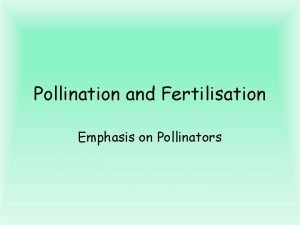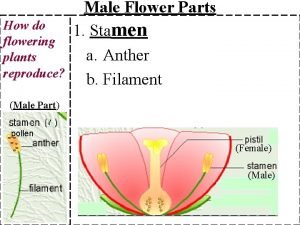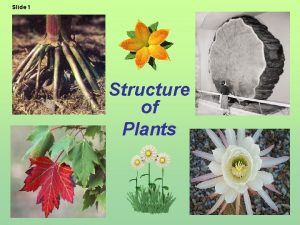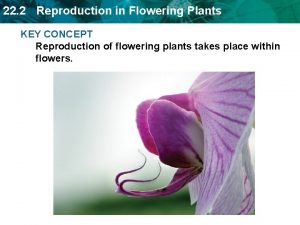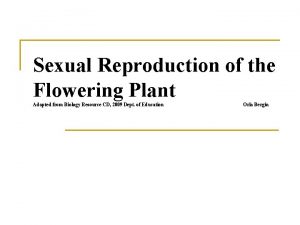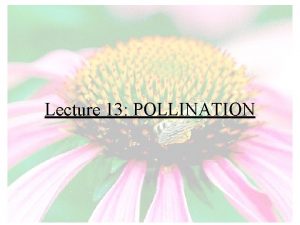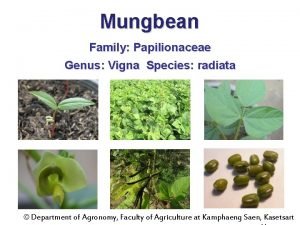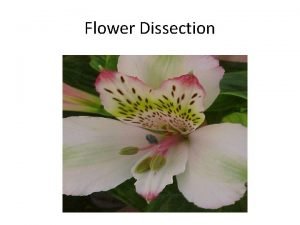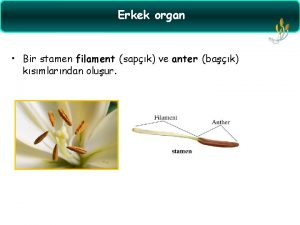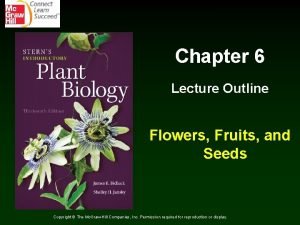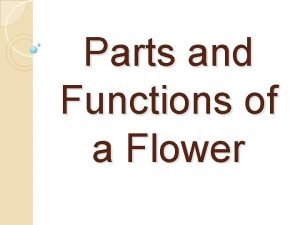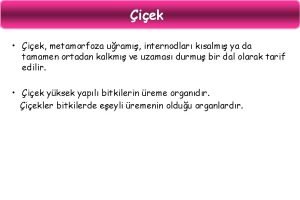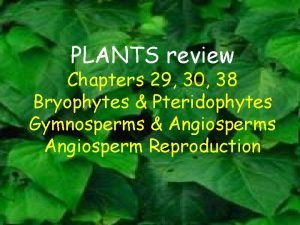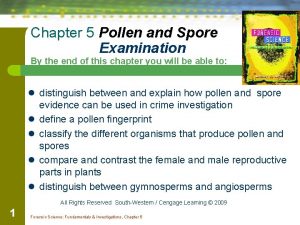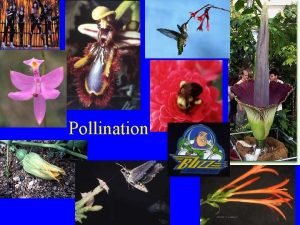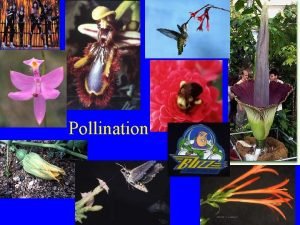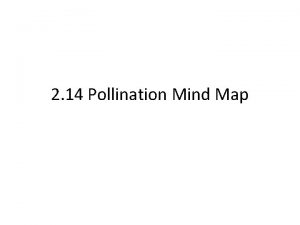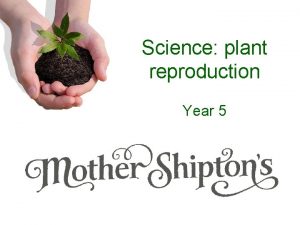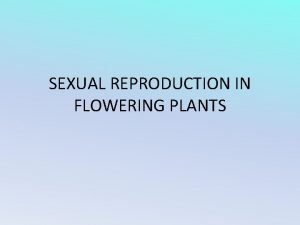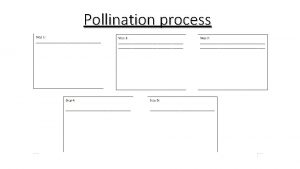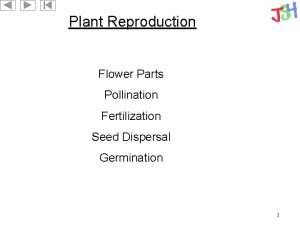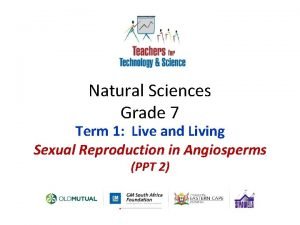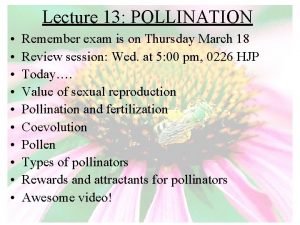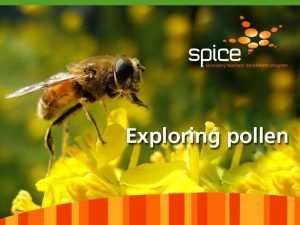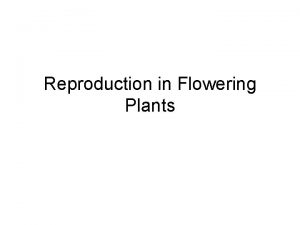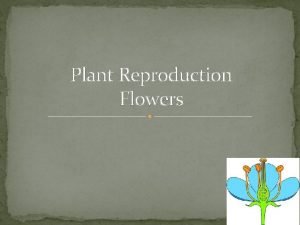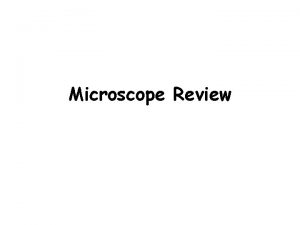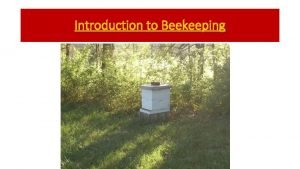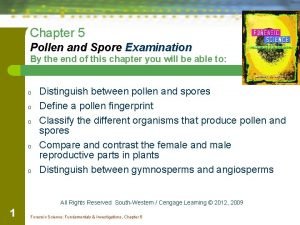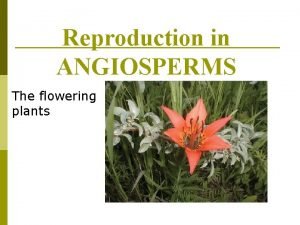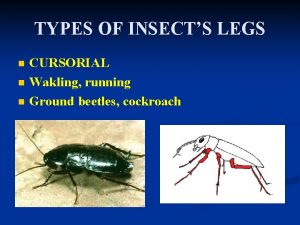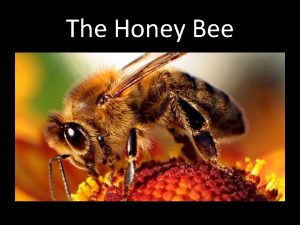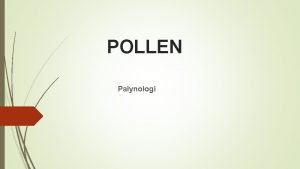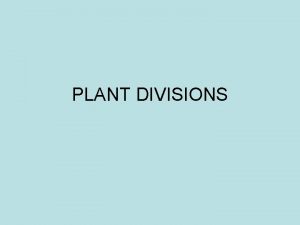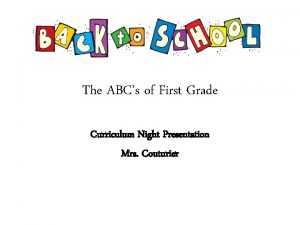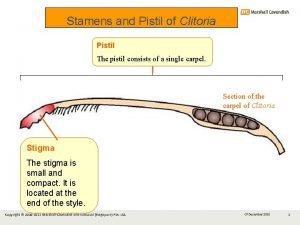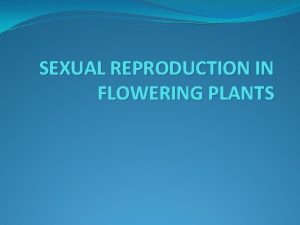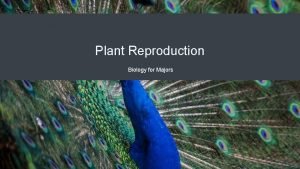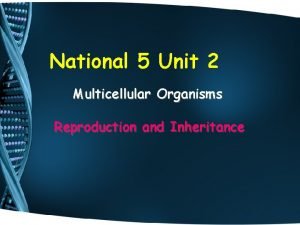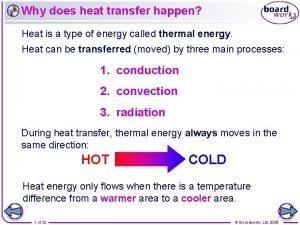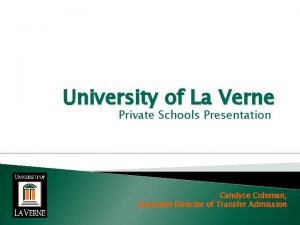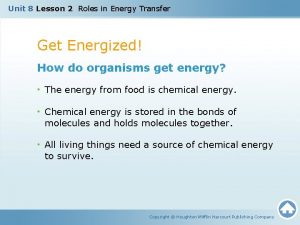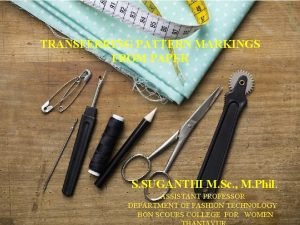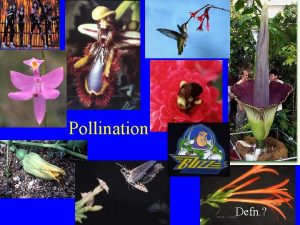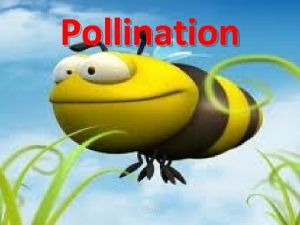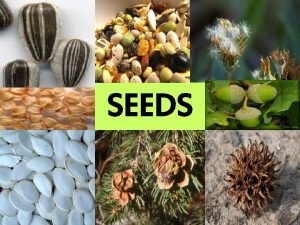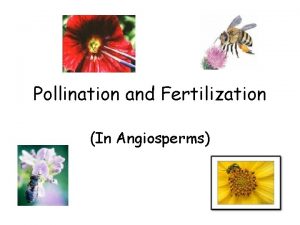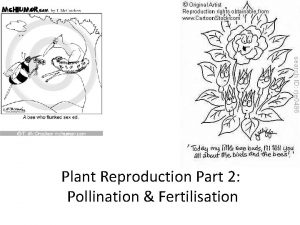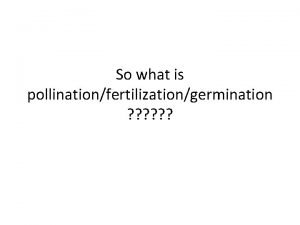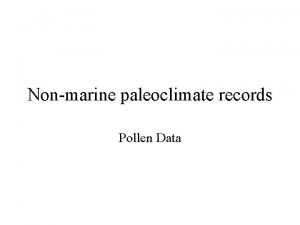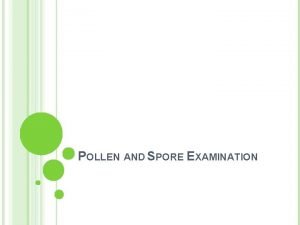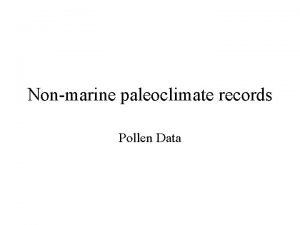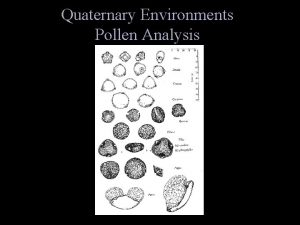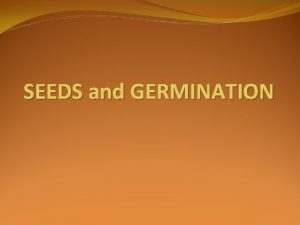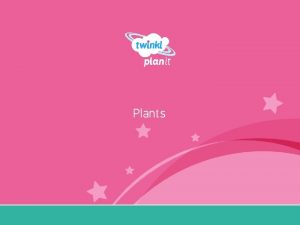Pollination Pollination Definition transfer of pollen from stamen













































































- Slides: 77

Pollination

Pollination • Definition: transfer of pollen from stamen to stigma • Contrast with herbivory. Animals eating plant products but: – 1) Most pollinators winged – 2) If insects, adults involved directly and not larvae – 3) Few mammals involved (except bats)

The flower • Parts (see Fig. 6 -1 in text)

Life Cycle • Example of sporic meiosis: • • Gametophytes make gametes BY MITOSIS Zygote grows into diploid individual called sporophyte Sporophyte makes meiospores BY MEIOSIS Two bodies in one cycle: alternation of generations

• Overview: Life Cycle

Life Cycle • Overview: • Fertilization: union of sperm with egg to form zygote

Floral variation • Parts may be fused • Example, petals fused to each other • Like parts fused: connation (ex. , petals to petals) • Unlike parts fused: adnation (ex. , stamens to petals). Snapdragon flower

Floral variation • Fusing of petals can form floral tube (nectar made at bottom) • Only long-tongued pollinators can reach it. Anisacanthus (Acanthaceae) flower

Floral variation • Flowers with both stamens and pistils: perfect flowers Another kind of perfection….

Floral variation • Flowers with both stamens and pistils: perfect flowers • Some flowers imperfect. Either pistillate (have pistil) or staminate (have stamens). Pistillate flowers of Sagittaria Staminate flowers of Sagittaria

Floral variation • Note: some species make pistillate flowers and carpellate flowers on separate individuals • This termed dioecy (MUST outcross to reproduce sexually) • Monoecy is when both sexes on same individual.

Floral variation Persimmon fruits • Example of dioecious species: Persimmon (Diospyros) Pistillate flower Staminate flower

Floral variation • Some flowers are missing one or more sets of basic parts: incomplete flowers • Note that all imperfect flowers are therefore incomplete!

Floral variation • Floral symmetry: • Radial: can be divided into similar halves by several planes • Bilateral: can be divided into mirror images by 1 plane.

Floral variation • Ovary position • Superior ovary: other parts attach below ovary (hypogynous: “hypo-” =below, “gyn-” =female)

Floral variation • Example of superior ovary in a lily flower (ovary is E)

Floral variation • Ovary position • Perigynous flower: ovary superior, but cup formed of fused sepals, petals, stamens around it.

Floral variation • Ovary position • Inferior ovary: other parts attach above ovary (epigynous: “epi-”=above, “gyn”=female).

Floral variation • Example of inferior ovary: squash flower (this one is pistillate). Ovary

Floral variation • • Some flowers assembled into groups of flowers: inflorescence Special inflorescence type: head Example, sunflower and its relatives Ray flowers have large fused petals (corollas fused), disk flowers small and crowded. ray flowers disk flowers

Floral variation • Flowering dogwood (Cornus florida) • Inflorescence: white structures are modified leaves (bracts) that act like petals. Inflorescence Closeup showing individual greenish flowers

Pollination • Why flowers so varied? Many form mutualism with animals to achieve pollination

Mutualism Exceptions • Some flowering plants are wind pollinated (anemophily) • Some are water pollinated (hydrophily) Small, greenish grass flowers

Pollination as Mutualism • Most flowering plants are pollinated by animals • This usually viewed as mutualism (where both species benefit) – Plant gets pollen transferred – Animal gets “reward”

Rewards • Pollen: high in protein • Also has lipids, minerals, starch • Can be renewed by: – sequential anther dehiscence (multiple stamens) – poricidal anthers (buzz pollination)

Rewards • Nectar: sugary fluid produced by nectar glands (nectaries) in flower • 10 -60% mono- or disaccharides • May have amino acids too (butterfly flowers) • Renewable reward!

Rewards • Oils/Resins: some used as construction materials, “cologne” (male solitary bee uses oil as female attractant), food for larvae (Krameria) • Edible petals (pineapple guava: New Zealand) Krameria wax gland: wasp food!

Pollination • Benefits of animal pollination for plant – 1) Directed dispersal of pollen. Can get delivered from stamen to stigma with less waste – Floral cues and attractants: • Color and shape • Scent • Warmth (thermogenic plants: rare) Skunk cabbage

Pollination • Benefits of animal pollination for plant – 1) Directed dispersal of pollen. – This aided by learning of floral visitors: decreases “handling time” – Fosters “floral constancy” (visiting single species on foraging trip) by bees Bumblebee visits to touch-me-not

Pollination • Benefits of animal pollination for plant – 2) Style of flower as “selective racetrack” stigma style ovary 2 ovules

Pollination • Benefits of animal pollination – 2) Style of flower as “selective racetrack” – Keep in mind that 1 pollen grain can fertilize 1 ovule – Suppose 5 pollen grains arrive on stigma Pollen grains stigma style ovary 2 ovules

Pollination • Benefits of animal pollination – 2) Style of flower as “selective racetrack” – Keep in mind that 1 pollen grain can fertilize 1 ovule – Suppose 5 pollen grains arrive on stigma – Start to make pollen tubes – How many can fertilize an ovule? Pollen grains stigma pollen tubes style ovary 2 ovules

Pollination • Benefits of animal pollination – 2) Style of flower as “selective racetrack” – Keep in mind that 1 pollen grain can fertilize 1 ovule – Suppose 5 pollen grains arrive on stigma – Start to make pollen tubes – How many can fertilize an ovule? – 2! First 2 to arrive! – Rest? LOSERS! Pollen grains stigma style ovary 2 ovules

Pollination • Benefits of animal pollination – 2) Style of flower as “selective racetrack” – Pollen tubes are haploid (1 n) – Haploid means only 1 allele (gene version) for every trait Pollen grains stigma style ovary 2 ovules

Pollination • Benefits of animal pollination – 2) Style of flower as “selective racetrack” – Pollen tubes are haploid (1 n) – Haploid means only 1 allele (gene version) for every trait – If an allele is recessive, then it will be expressed (can’t be masked by another, dominant allele) Pollen grains stigma style ovary 2 ovules

Pollination • Benefits of animal pollination – 2) Style of flower as “selective racetrack” – Pollen tubes are haploid (1 n) – Haploid means only 1 allele (gene version) for every trait – If an allele is recessive, then it will be expressed (can’t be masked by another, dominant allele) – So, fittest (fastest) pollen grains mate – Inferior genes don’t get passed to offspring. 2 ovules Pollen grains stigma style ovary

Pollination • Style of flower as “selective racetrack” • Is there evidence that this works? • Example, Coyote melon • Gourd growing in U. S. deserts.

Pollination • Style of flower as “selective racetrack” • Study done in 2000 showed that – 1) takes 900 pollen grains to fully pollinate flower – 2) 1 pollinator visit puts 650 grains/flower. By 2 hours, >4000 grains deposited on stigma – 3) Seeds produced from over-pollinated flowers produced more vigorous seedlings (compared to seeds from flowers with <900 pollen grains on stigma).

Outcrossing • Major benefit of sexual reproduction: generate genetic variation • This enhanced by mating with others (outcrossing)

Outcrossing • How to favor outcrossing: • 1) Dioecy Imperfect flowers Bet hedging! Some selfing can occur if no cross pollination

Outcrossing • How to favor outcrossing: • 2) Floral morphology • Heterostyly: Distyly and tristyly

Outcrossing • • How to favor outcrossing: 3) Floral phenology Protandry: anthers dehisce first Protogyny: stigma becomes receptive first Protandry

Outcrossing • How to favor outcrossing: • 4) Self-incompatibility: prevents germination of self pollen or slows self pollen tube growth

Pollinator Specialization • May be learned • May be species-specific – Monolecty: Flowers of 1 plant species visited – Oligolecty: Flowers of few plant species visited – Polylecty: Flowers of many plant species visited

Specialization • Benefits of taxonomic specialization – Better service: can match phenology of plant/pollinator – Decrease competition (must match flower/pollinator traits) – Plant: Minimize stigma clogging with heterospecific pollen

Pollination syndromes • Disclaimer: Note that we must make broad generalizations and exceptions exist to most statements!

Pollination syndromes • Bee pollination: Melittophily • Bees: – – intelligent, agile visual animals: good eyesight (including UV light) good smellers (good sense of smell) day-active

Pollination syndromes • Bee pollination • Bee pollinated flowers: – Colorful (usually not red) – Landing platform: place where bee can land on flower – Mildly fragrant. – Nectar guides: patterns of lines or dots that can guide bee to reward – Sometimes these only visible in UV light (which bees see). Petals in visible light (left) and UV (rt)

Pollination syndromes • Fremontodendron decumbens (endangered chaparral shrub) flowers • UV reflectance photo (right)

Pollination syndromes • Beetle pollination: Cantharophily • Beetles are: – – Clumsy Have poor vision Dumb(er) Active during the day (many flower-visiting ones).

Pollination syndromes • Beetle pollination • Beetle pollinated flowers are: – Relatively large or grouped into large inflorescences – Light colored – Smelly (fruity or spicy smell) Dogwood inflorescence Inflorescence of Xanthosoma with beetle from it

Pollination syndromes • Bird pollination: Ornithophily • Birds are: – agile – long-beaked – visual: see red colors well – poor “smellers” – Hummingbirds (native to Americas) can hover!

Pollination syndromes • Bird-pollinated flowers are: – – Aloe red or orange have nectar hidden by long floral tube little or no fragrance no landing platform Anisacanthus (Acanthaceae) flower

Pollination syndromes • Bird pollination: not always by hummingbirds • Other birds from other areas: – Sunbirds (Africa/Asia) – Honeycreepers (Hawai’i). Golden-winged sunbird Iiwi (a honeycreeper) Crested honeycreeper

Pollination syndromes • Butterfly pollination: Psychophily • Butterflies have: good vision, good sense of smell, long coiled tongue. Must land on flower to visit it (can’t hover). tongue extended coiled tongue

Pollination syndromes • Butterfly-pollinated flowers: – Color varies (blue, yellow, orange) – Landing platform present – Nectar at bottom of floral tube Plumbago flowers Phlox flowers

Pollination syndromes • Fly pollination: Myophily • Flies have good sense of smell, especially flesh flies • Attracted to rotting meat (lay eggs in meat, larvae are maggots).

Pollination syndromes • Fly-pollinated flowers: Sapromyophily – Smell like rotting meat – Look like rotting meat (dark red, purple) – Offer no reward: flies fooled by flower. Stapelia flower

Fly flower story: Rafflesia • Ex, Rafflesia of Sumatra • Root parasite • Flower is only above-ground part.

Fly flower story: Rafflesia • Ex, Rafflesia of Sumatra • Largest single flower on Earth.

Pollination syndromes • Fly pollination • Largest inflorescence is made by flypollinated plant • Corpse-flower. Inside view

Pollination syndromes • Bat pollination: Chiropterophily • Bats are flying mammals – – Nocturnal Eyesight good but echolocate Good sense of smell Agile, can hover when visiting flower.

Pollination syndromes • Bat pollination • Bat-pollinated flowers – – – Open at night Lots of pollen and nectar as rewards White or light-colored Fragrant (sweet) May be pendant (hang from branches). Parkia flowers

Pollination syndromes • Bat pollination • Bat-pollinated flowers – May also be made on tree trunks (tropics): Cauliflory – Ex, cannonball tree of South America

Pollination syndromes • Bat pollination: Mainly a tropical phenomenon • In U. S. , saguaro cactus is one of few bat-pollinated species. Saguaro cactus Saguaro flowers

Pollination syndromes • Moth pollination: Phalaenophily • Moths have: – Poor vision (nocturnal) – Excellent sense of smell – Long coiled tongue.

Pollination syndromes • Moth pollination • Moths: – Some (hawkmoths) can hover when visiting flowers. Hawkmoth

Pollination syndromes • Moth pollination • Moth-pollinated flowers: – – Open at night Sweet fragrance White or light-colored Nectar in tube.

Pollination syndromes • Interesting moth story: nectar spur • Nectar spur is long pouch, at bottom of which is nectar • Moth uses long tongue to reach nectar Nectar spurs on columbine

Pollination syndromes • • Interesting moth story: nectar spur Nectar spur is long pouch, at bottom of which is nectar Moth uses long tongue to reach nectar Only if tube is longer than tongue will moth have to push into flower far enough to pick up pollen • So, long spurred flowers reproduce better.

Pollination syndromes • Which leads to longer moth tongues to reach all of the nectar in the longer tubes • Which leads to longer tubes. . .

Pollination syndromes • Which leads to longer moth tongues to reach all of the nectar in the longer tubes • Which leads to longer tubes. . . • Some moth-pollinated orchids with long nectar spurs (almost one foot long!) • Moth has extremely long tongue!

Pollination syndromes • Moth pollination • Angraecum orchid from Madagascar. Nectar spur almost 1 foot long!

Pollination syndromes • Can read more in magazine for Gene Simmons fans. Gene Simmons from KISS

Sexual Mimics • Flowers that mimic female bees or wasps • Look like females • Smell like females: chemical mimicry. One study showed flower more attractive than real female!! Sexual mimic orchids

Pollination syndromes • Sexual mimics • Males attempt to mate (pseudocopulation), pick up pollen, then fly to another flower and repeat process • No reward supplied!. A male wasp “mating” with an Ophrys flower (how embarrassing. . . )

Pollination syndromes • Another trick flower • Grass pink orchid (Calopogon): grows in pitcher plant bogs in SE US • Makes fake stamens on petal. Cattleya orchid (flower made right side up) Plant ecology class in bog Calopogon orchid (flower made upside down!)
 Self pollination
Self pollination Male parts of a flower
Male parts of a flower What does ovule contain
What does ovule contain Pollination occurs when a pollen grain
Pollination occurs when a pollen grain Stigma function
Stigma function What is pollination
What is pollination Diadelphous stamen
Diadelphous stamen Stipel leaf
Stipel leaf Alstroemeria sepals
Alstroemeria sepals Anter ve filament
Anter ve filament Webtoon indonesia
Webtoon indonesia Multiple fruit vs aggregate fruit
Multiple fruit vs aggregate fruit Functions of pistil
Functions of pistil Sepal
Sepal Bryophytes pteridophytes gymnosperms and angiosperms
Bryophytes pteridophytes gymnosperms and angiosperms A pollen fingerprint is the
A pollen fingerprint is the Pollinate definition
Pollinate definition Pollination syndrome
Pollination syndrome Pollination mind map
Pollination mind map Pollination fertilisation seed dispersal germination
Pollination fertilisation seed dispersal germination Purpose of pollination
Purpose of pollination Papaver syncarpous
Papaver syncarpous Flower reproductive parts
Flower reproductive parts Pollination experiment
Pollination experiment Pollination
Pollination Types of pollination agents
Types of pollination agents Pollination process
Pollination process Flower parts
Flower parts Grade 7 natural science term 1 2021
Grade 7 natural science term 1 2021 Pollination
Pollination Wave is a disturbance that transfers energy
Wave is a disturbance that transfers energy Size of pollen
Size of pollen Parts of a male flower
Parts of a male flower Polarity of pollen grain
Polarity of pollen grain What does the stem do for the plant
What does the stem do for the plant Parts of a flower and their functions
Parts of a flower and their functions A student determined that exactly 10 pollen grains
A student determined that exactly 10 pollen grains Pollen color chart
Pollen color chart Part of flower that makes pollen
Part of flower that makes pollen Chapter 5 pollen and spore examination review answers
Chapter 5 pollen and spore examination review answers Pollen analysis
Pollen analysis Part of a flower comprising stigma style and ovary
Part of a flower comprising stigma style and ovary Natatorial legs insects
Natatorial legs insects Pollen basket
Pollen basket Bipollen farligt
Bipollen farligt What are the plant divisions?
What are the plant divisions? Noita pollen
Noita pollen Diagram of germination of pollen on stigma
Diagram of germination of pollen on stigma Agamospory
Agamospory Pollen color chart
Pollen color chart Corn cob
Corn cob Is pollen unicellular or multicellular
Is pollen unicellular or multicellular Loaded word examples
Loaded word examples Welding chapter 10 review answers
Welding chapter 10 review answers Automatic pipette types
Automatic pipette types Card stacking examples in advertising
Card stacking examples in advertising Chapter 11 positioning moving and lifting
Chapter 11 positioning moving and lifting Whitefield nh transfer station
Whitefield nh transfer station Work is the transfer of energy
Work is the transfer of energy A teacher applies a force to a wall and becomes exhausted.
A teacher applies a force to a wall and becomes exhausted. Heat transfer on metal
Heat transfer on metal Running buffer 역할
Running buffer 역할 Fts file transfer
Fts file transfer Disturbance that transfers energy but not matter
Disturbance that transfers energy but not matter Waves transfer energy without transferring
Waves transfer energy without transferring Uncompactable
Uncompactable Vanderbilt technology transfer
Vanderbilt technology transfer Near transfer examples
Near transfer examples La verne law school transfer
La verne law school transfer Seven fundamental
Seven fundamental Roles in energy transfer
Roles in energy transfer How is thermal energy transferred?
How is thermal energy transferred? Udp-based data transfer protocol
Udp-based data transfer protocol Pyramids of energy transfer
Pyramids of energy transfer Transvers friksiyon masajı
Transvers friksiyon masajı How to transfer pattern markings onto fabric
How to transfer pattern markings onto fabric Transfer student resume examples
Transfer student resume examples Transfer price
Transfer price
